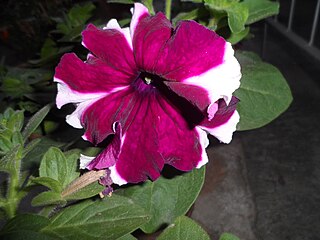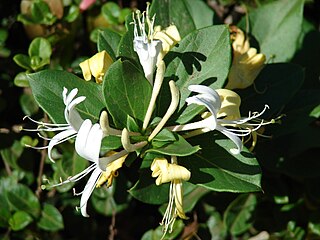
Eugenol is an allyl chain-substituted guaiacol, a member of the allylbenzene class of chemical compounds. It is a colorless to pale yellow, aromatic oily liquid extracted from certain essential oils especially from clove, nutmeg, cinnamon, basil and bay leaf. It is present in concentrations of 80–90% in clove bud oil and at 82–88% in clove leaf oil. Eugenol has a pleasant, spicy, clove-like scent. The name is derived from Eugenia caryophyllata, the former Linnean nomenclature term for cloves. The currently accepted name is Syzygium aromaticum.

Coniferyl alcohol is an organic compound with the formula HO(CH3O)C6H3CH=CHCH2OH. A colourless or white solid, it is one of the monolignols, produced via the phenylpropanoid biochemical pathway. When copolymerized with related aromatic compounds, coniferyl alcohol forms lignin or lignans. Coniferin is a glucoside of coniferyl alcohol. Coniferyl alcohol is an intermediate in biosynthesis of eugenol and of stilbenoids and coumarin. Gum benzoin contains significant amount of coniferyl alcohol and its esters. It is found in both gymnosperm and angiosperm plants. Sinapyl alcohol and paracoumaryl alcohol, the other two lignin monomers, are found in angiosperm plants and grasses.

Chalcone synthase or naringenin-chalcone synthase (CHS) is an enzyme ubiquitous to higher plants and belongs to a family of polyketide synthase enzymes (PKS) known as type III PKS. Type III PKSs are associated with the production of chalcones, a class of organic compounds found mainly in plants as natural defense mechanisms and as synthetic intermediates. CHS was the first type III PKS to be discovered. It is the first committed enzyme in flavonoid biosynthesis. The enzyme catalyzes the conversion of 4-coumaroyl-CoA and malonyl-CoA to naringenin chalcone.
In enzymology, a (iso)eugenol O-methyltransferase is an enzyme that catalyzes the chemical reaction
In enzymology, a secologanin synthase (EC 1.14.19.62, was wrongly classified as EC 1.3.3.9 in the past) is an enzyme that catalyzes the chemical reaction

Cinnamoyl-CoA reductase (EC 1.2.1.44), systematically named cinnamaldehyde:NADP+ oxidoreductase (CoA-cinnamoylating) but commonly referred to by the acronym CCR, is an enzyme that catalyzes the reduction of a substituted cinnamoyl-CoA to its corresponding cinnamaldehyde, utilizing NADPH and H+ and releasing free CoA and NADP+ in the process. Common biologically relevant cinnamoyl-CoA substrates for CCR include p-coumaroyl-CoA and feruloyl-CoA, which are converted into p-coumaraldehyde and coniferaldehyde, respectively, though most CCRs show activity toward a variety of other substituted cinnamoyl-CoA's as well. Catalyzing the first committed step in monolignol biosynthesis, this enzyme plays a critical role in lignin formation, a process important in plants both for structural development and defense response.
The enzyme S-linalool synthase (EC 4.2.3.25) catalyzes the chemical reaction
Eugenol synthase (EC 1.1.1.318, LtCES1, EGS1, EGS2) is an enzyme with systematic name eugenol:NADP+ oxidoreductase (coniferyl ester reducing). This enzyme catalyses the following chemical reaction: eugenol + a carboxylate + NADP+ a coniferyl ester + NADPH + H+

Chlorophyllide-a oxygenase (EC 1.14.13.122), chlorophyllide a oxygenase, chlorophyll-b synthase, CAO) is an enzyme with systematic name chlorophyllide-a:oxygen 7-oxidoreductase. This enzyme catalyses the following chemical reactions
2-hydroxyisoflavanone synthase (EC 1.14.13.136, CYT93C, IFS, isoflavonoid synthase) is an enzyme with systematic name liquiritigenin,NADPH:oxygen oxidoreductase (hydroxylating, aryl migration). This enzyme catalyses the following chemical reactions:
(Z)-3-hexen-1-ol acetyltransferase is an enzyme with systematic name acetyl-CoA:(3Z)-hex-3-en-1-ol acetyltransferase. This enzyme catalyses the following chemical reaction
Benzyl alcohol O-benzoyltransferase is an enzyme with systematic name benzoyl-CoA:benzyl alcohol O-benzoyltransferase. This enzyme catalyses the following chemical reaction
(+)-α-Barbatene synthase is an enzyme with systematic name (2E,6E)-farnesyl-diphosphate diphosphate-lyase ( -α-barbatene-forming). This enzyme catalyses the following chemical reaction
β-Chamigrene synthase is an enzyme with systematic name (2E,6E)-farnesyl diphosphate lyase . This enzyme catalyses the following chemical reaction
Thujopsene synthase is an enzyme with systematic name (2E,6E)-farnesyl diphosphate lyase . This enzyme catalyses the following chemical reaction
(E)-β-Ocimene synthase (EC 4.2.3.106, β-ocimene synthase, AtTPS03, ama0a23, LjEbetaOS, MtEBOS) is an enzyme with systematic name geranyl-diphosphate diphosphate-lyase ((E)-β-ocimene-forming). This enzyme catalyses the following chemical reaction
(+)-Car-3-ene synthase is an enzyme with systematic name geranyl-diphosphate diphosphate-lyase [cyclizing, (+)-car-3-ene-forming]. This enzyme catalyses the following chemical reaction

Petunia × atkinsiana is a Petunia plant "nothospecies" (hybrid), which encompasses all hybrid species of petunia between P. axillaris and P. integrifolia. Most of the petunias sold for cultivation in home gardens are this type and belong to this nothospecies.

Floral scent, or flower scent, is composed of all the volatile organic compounds (VOCs), or aroma compounds, emitted by floral tissue. Other names for floral scent include, aroma, fragrance, floral odour or perfume. Flower scent of most flowering plant species encompasses a diversity of VOCs, sometimes up to several hundred different compounds. The primary functions of floral scent are to deter herbivores and especially folivorous insects, and to attract pollinators. Floral scent is one of the most important communication channels mediating plant-pollinator interactions, along with visual cues.







